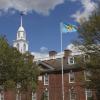Boyer dedicates life to animal-human bond
Kelly Boyer was 10 years old when she started riding lessons. She’s never looked back.
“I was hooked at a young age,” she said.
Growing up in Baltimore County, Boyer competed in hunter shows before turning to dressage. Her riding skills landed her on the University of Delaware equestrian team, for which she rode until graduating in 1997 with a bachelor’s degree in animal science and a minor in business.
The first job she landed out of college was with a nonprofit that trained service dogs for individuals with disabilities. “I was drawn to working with animals,” she said.
After her parents moved to the Cape Region, she made a life change and headed to Sussex County. She worked for a physical therapy group part time, which gave her flexibility to do something else.
She filled her extra time as a volunteer with the original Southern Delaware Therapeutic and Recreational Horseback Riding group started by Katrina Burroughs in collaboration with the Sussex Consortium and the local Kiwanis club on a 10-acre parcel on Beaver Dam Road.
“I answered an ad that I saw in the Cape Gazette,” Boyer said.
The facility moved a few times, and Burroughs moved back to Sweden before the facility shortened its name to Southern Delaware Therapeutic Riding and set up its permanent home on Route 5 between Harbeson and Milton in 2015.
When Burroughs left, Boyer said, she and two other volunteers made the decision to keep the program going. Boyer became a certified therapeutic riding instructor, combining her love of working with animals and helping people.
SDTR has expanded over the years. It still offers therapeutic horseback riding for Sussex Consortium students, but also students from Howard T. Ennis school in Georgetown, children from Children’s Beach House and veterans from Operation SEAs the Day. Parents can sign their children up for the program, Boyer said, and there are 15 to 18 regular participants.
“Two come at a time, twice a week,” she said.
The program has eight horses that it leases, but pays for veterinary, blacksmith and all other expenses associated with the animals.
“What I love most about the program is watching the healing power of the horse and the nonjudgmental love that they give us,” she said. “While working with students, you see an increase in their self-esteem and a connection with the horse.”
The SDTR team and participants also form a bond. “It’s very encouraging and supportive,” she said.
In 2020, Boyer became program director for SDTR, and she also serves on the six-member board and the five-member executive committee.
For more information about SDTR, go to www.sdtrhr.com.
Melissa Steele is a staff writer covering the state Legislature, government and police. Her newspaper career spans more than 30 years and includes working for the Delaware State News, Burlington County Times, The News Journal, Dover Post and Milford Beacon before coming to the Cape Gazette in 2012. Her work has received numerous awards, most notably a Pulitzer Prize-adjudicated investigative piece, and a runner-up for the MDDC James S. Keat Freedom of Information Award.




















































